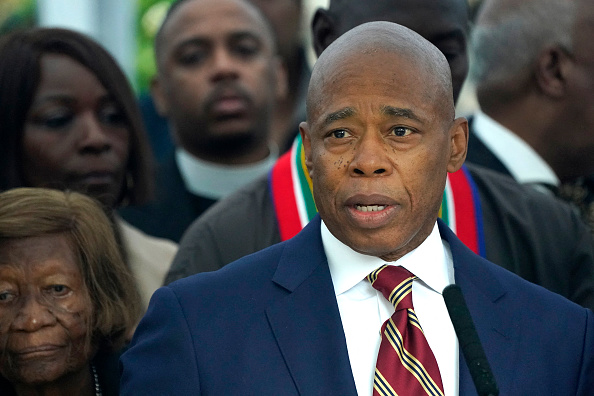For reasons I don’t even pretend to understand, Robert F. Kennedy, Jr. (RFK), who has dropped out of the presidential race and endorsed Donald Trump, still wants to remain on the ballot in some (but not all) states. Last Friday his bid to have the U.S. Supreme Court require New York officials to include him on New York’s ballot failed. New York had excluded him because, New York courts found, he did not give accurate information in response to a question posed of independent candidates who seek to vie for New York’s electors: where is your place of residence? New York maintains that obtaining accurate information about a candidate’s place of residence helps reduce fraud and voter confusion, and also that equality principles counsel against relieving some but not all independent candidates of the requirement to provide accurate residence information.
In their filings asking the Supreme Court to undo the decision by New York officials, RFK’s lawyers argued, among other things, that New York’s requirement that candidates have and accurately disclose a place of residence violates the Constitution, because it amounts to a state adding presidential qualifications beyond those set out in Article II of the Constitution (natural-born citizenship, age and U.S. durational residency), and thus runs afoul of the Supreme Court’s 1995 ruling in U.S. Term Limits, Inc. v. Thornton. Here is what RFK’s papers at the Court said:
The Presidential Qualifications Clause sets forth the exclusive requirements for eligibility for the Office of the President: No Person except a natural born Citizen… shall be eligible to the Office of President, neither shall any Person be eligible to that Office who shall not have attained to the Age of thirty five Years, and been fourteen Years a Resident within the United States. . . . The Framers intended the Qualifications Clause to “fix as exclusive the qualifications in the Constitution,” U.S. Term Limits, Inc. v. Thornton, 514 U.S. 779, 806 (1995), “thereby ‘divest[ing]’ States of any power to add qualifications.” Id. at 801. States do not “possess the power to supplement the exclusive qualifications set forth in the text of the Constitution.” Id. at 827. . . . The Residence Requirement violates this prohibition by imposing an additional qualification on an independent presidential candidate seeking ballot access in New York: that they must have a fixed permanent home to which they always intend to return. New York has no authority to bar persons without a “fixed” home from running for President. Under the Qualifications Clause, an individual who has no permanent home—for example, a member of the military who has been deployed to various locations for many years without ever establishing a permanent home anywhere—is as entitled to run for President as anyone else who satisfies the Clause’s three requirements. For that matter, so is a homeless person.
RFK’s team likely knew its request to the Supreme Court was a longshot, especially given the temporal proximity to the election and some high procedural hurdles RFK faced. But even more imposing than these obstacles is the complete untenability of their argument on the merits and its invocation of the Term Limits case. To be sure, RFK is not the only one who has shoddily invoked the Term Limits ruling in the presidential selection setting, but it is time to put an end to such analytic sloppiness. (I try to do so more thoroughly in a forthcoming article in the Wisconsin Law Review, which builds on many of the points I offer here.) With all due respect, those who invoke the Term Limits as being a hurdle in the presidential context are just not being careful about logic, history or doctrine. (For these purposes, I will assume that the 5-4 Term Limits decision—whose result I think was right on statutory grounds if not the constitutional rationale offered by Justice Steven’s majority opinion—remains good law. But that assumption is itself open to question. Of the current Justices, only Justice Clarence Thomas was on the Court in 1995, and he penned the incredibly voluminous and detailed dissent for himself and the three other dissenters—Chief Justice William Rehnquist, Justice Sandra Day O’Connor, and Justice Antonin Scalia—three Justices whose views on states’ autonomy generally speaking align with the current conservative majority on the Court.)
As for logic, while Term Limits did strike down an Arkansas voter-enacted initiative that sought to prevent long-term congressional incumbents from having their names appear on congressional election ballots, the ruling simply cannot stand for the proposition that states may not, in the absence of a constitutional amendment, impose additional qualification requirements on any would-be federal officials federally elected officials. To see this, start by taking a closer look at even House member candidates at issue in Term Limits. If a particular individual voter announced that she was not going to consider any long-term incumbents for re-election—not that past officeholding would be one Grutter-like factor in her interpersonal comparison of candidates, but that she would literally set aside long-term incumbents and not consider them—no one would suggest that she was impermissibly adding qualifications to the office. And the reason wouldn’t simply relate to questions about whether she was a state actor. If you need more convincing, consider a president (clearly a state actor) who needs to fill a vice-presidential vacancy under the 25th Amendment. Like presidents, vice presidents under the Constitution (the Twelfth Amendment in particular) need only satisfy prescribed qualifications relating to age, natural-born citizenship, etc. But if a President announced publicly that she would not consider nominating any candidate who violated a prior oath to uphold the Constitution or who had lied about where he lived (or if Congress announced it would not consider and vote on any such person who were nominated), no one would think that additional qualifications were being impermissibly imposed. That is because, as a logical matter, the person or persons to whom the Constitution delegates authority to make a selection can (as a general matter limited only by other, specific constitutional provisions) adopt and act on limitations on the kinds of persons to be considered.
The problem in Term Limits owed to the fact that under Article I, section 2 (and, later, the 17th Amendment) the persons who are constitutionally charged with picking House Members (and later Senators) are (at least according to the five-Justice Term Limits majority) the individual voters in each state, not the elected legislature or people of each state collectively, who in Arkansas had tried to constrain the individual voters.
But with respect to presidential elections, under Article II it is the states—and clearly no particular person or body within them—that are charged with the task of choosing and appointing electors presidential electors. That is why, as an historical matter, states right after ratification were able to and did impose additional qualifications on presidential electors, beyond the two qualification requirements in the Constitution that electors not be members of Congress or federal officeholders. For example, Maryland required electors to come from different parts of the state. An intra-state residency requirement, where the Constitution requires nothing about the residency of presidential electors—unlike House Members and Senators, electors need not be residents of the state, much less residents of particular parts of the states—is an example of an early qualification requirement. And over the last 100-plus years, the vast majority of states have imposed another qualification on would-be electors: that they pledge support for one party or one presidential aspirant prior to being appointed as an elector. As the Court held in Cook v. Gralike (which involved congressional candidates who were required to make a pledge), insisting that a candidate take a pledge is tantamount to imposing an additional qualification, because those unwilling to take the pledge simply are not allowed to be considered.
Remarkably, those who have invoked Term Limits in the context of discussions of states’ participation in presidential selection hardly (if at all) mention that Term Limits involved Congress and Article I, not the presidency and Article II. In this regard, notice the misleading quotations in the passage from RFK’s Supreme Court papers excerpted above; both of the quotes from Term Limits that address the “fixed” nature of “qualifications” come from sentences in the opinion referring to congressional qualifications specifically, not presidential qualifications. But reliance on Article I for presidential selection is unavailing because Article I involves a setting—legislative contests—in which the Constitution requires that states hold elections by the people themselves. When popular elections are constitutionally mandated, the requirements states can impose for ballot access are necessarily constrained. A constitutionally prescribed election “by the people” presupposes that the people—and not the state officials—do the choosing. But of course the Constitution does not require states to hold popular elections with regard to the presidency at all. Consider the words of the Supreme Court in Bush v. Gore (in a part of the opinion that did not generate huge legal criticism or controversy):
The individual citizen has no . . . right to vote for electors for the President of the United States unless and until the state legislature chooses a statewide election as the means to implement its power to appoint members of the Electoral College. U.S. Const., Art. II, §1. This is the source for the statement in McPherson v. Blacker, 146 U. S. 1, 35 (1892), that the State legislature’s power to select the manner for appointing electors is plenary; it may [even today], if it so chooses, select the electors itself, which indeed was the manner used by State legislatures in several States for many years after the Framing of our Constitution. . . . The State, of course, after granting the franchise in the special context of Article II, can take back the power to appoint electors. See id., at 35 (“[T]here is no doubt of the right of the legislature to resume the power at any time, for it can neither be taken away nor abdicated”) (quoting S. Rep. No. 395, 43d Cong.,1st Sess.).
And when we compare other nuances in Articles I and II, we see further ways in which the Constitution delegated very different powers to states. In Article I, with regard to congressional contests, states are given the provisional power to regulate only the “Times, Places and Manner”—but not the substance—of these constitutionally required elections. Moreover, Congress is given power to override states even with regard to times, places and manner of the elections.
By contrast, in Article II, states are given the entire power/duty to appoint presidential electors in any way they choose. Again, popular elections are not required; states are given power over not just the manner of election, but the manner of selection. And Congress is denied any authority to second-guess whatever the means that states settle on to pick their electors—Congress’s power is instead limited to prescribing the timeline for picking the electors.
To illustrate all this, imagine a state (say California) decided to empower its elected legislature to appoint electors without use of any popular vote or other electorate-sentiment-gathering device (the way many states did in the earliest decades after ratification). If the California legislators announced they would meet on National Election Day to interview presidential aspirants, each represented by a proposed slate of electors, to decide which group of electors to appoint, and made clear that only Democratic Party aspirants would be invited to interview, that would be completely permissible. Or imagine the legislators announced that “no one whom a court has found to have interfered with the peaceful post-election transfer of power will be considered and interviewed.” That too would be unassailable. Indeed, it is hard to imagine the early state legislatures that picked electors themselves (and, again, there were many) were open to all comers and actually “considered” people of every political or ideological or experiential stripe. They imposed “qualifications” with respect to the presidential aspirants they would support whether those qualifications were overt or just clearly understood by the key players. And no one would suggest they had even technically to be open to considering everyone who met the minimal qualifications laid out in Article II. As Justice Thomas has correctly observed, “the right to choose . . . involve[s] the right to winnow.”
The failure of people who invoke Term Limits in the presidential setting to discuss any of the differences between congressional and presidential selection is all the more surprising and troubling because all of the logical and historical observations I just made are evident, if one reads carefully, in what the various Justices in Term Limits actually said. That is, Term Limits’s explicit reasoning—both of the majority and the 4-member dissent—make its holding inapplicable to the selection of presidential electors:
- The Term Limits majority says the rejection of state power to impose qualifications on House/Senate members follows from “the text and structure of the Constitution, the relevant historical materials, and, most importantly, the ‘basic principles of our democratic system’. . . .” The text that the majority invokes are the words of Article I, which delegate power to choose Congresspersons to the “people,” not Article II, which explicitly confers appointment power on “states” to appoint electors.
- The history the majority adduces (including the reliance on Federalist No. 52 and Federalist No. 57) focuses almost exclusively on “that part” of the federal government (i.e., the House of Representatives) as to which the Constitution requires direct election by the people.
- The “basic principles of our democratic system” the majority highlights as the most important factor is the sovereignty of the people—as individuals—to “choose whom they please to govern them” with respect to congressional elections. The majority quotes Federalist No. 15 for the idea that the central vice of the Articles of Confederation was its location of power exclusively in “States or Governments, in their Corporate or Collective Capacities, as contradistinguished from the Individuals of whom they consist.” None of this applies in settings where popular elections are not required, as they clearly are not under Article II.
- In this very regard, the majority distinguishes the Senate from the House at the Founding, saying that it was not until the 17th Amendment, in 1913, that “this idea [of popular sovereignty by individual voters] was extended to elections for the Senate.” The Court says the absence in the original Constitution of popular elections by the individual voters for the Senate explains why an early draft of the Constitution that made explicit that additional qualifications for House members could not be added contained no such provision for Senators, insofar as “the draft contemplated that Senators, unlike Representatives, would not be chosen by direct election.”
- The majority relied as well, for the idea that states have no power to add qualifications in the realm of congressional qualifications, on the fact that Article I, section 4’s backup provision of congressional power was a reflection of concern over the “abuse” of states with regard to congressional-election regulation; of course, no such backup provision exists with regard to the electoral college, nor could “abuse” by states explain a presidential election system that so overtly delegates vast and unregulated power directly to the states.
- The majority deflects the district-residency requirements some early states imposed on House candidates as not illustrating state power to add qualifications because “States may simply have viewed district residency requirements as the necessary analogy to [constitutionally required] state residency requirements.” This argument is unavailable to explain early state intrastate residency requirements with respect to presidential electors (as in Maryland), since the Constitution doesn’t impose any residency requirements on presidential electors.
Also quite revealing is that the majority does not dispute the premises of either of two key passages from Justice Thomas’s dissent. One is:
[T]he right to choose may include the right to winnow. . . . To appreciate this point, it is useful to consider the Constitution as it existed before the Seventeenth Amendment was adopted in 1913. The Framers’ scheme called for the legislature of each State to choose the Senators from that State. Art. I, § 3, cl. 1. The majority offers no reason to believe that state legislatures could not adopt prospective rules to guide themselves in carrying out this responsibility . . . [Since t]here is no reason to believe that the Framers’ Constitution barred state legislatures from adopting prospective rules to narrow their choices for Senator, then there is also no reason to believe that it barred the people of the States from adopting prospective rules to narrow their choices for Representative.
The only part of the majority opinion that implicitly addresses this argument is the majority’s conclusion that “people” in Article I means individuals, not people acting in a collective lawmaking capacity.
The dissent’s second super-relevant passage that the majority never disputes at all, which would be quite surprising had the majority opinion been intended to cover selection of presidential electors, is this:
the Constitution’s treatment of Presidential elections actively contradicts the majority’s position. While the individual States have no “reserved” power to set qualifications for the office of President [in the sense that states can’t dictate which presidential candidates that other states are able to support], we have long understood that they do have the power (as far as the Federal Constitution is concerned) to set qualifications for their Presidential electors — the delegates that each State selects to represent it in the electoral college that actually chooses the Nation’s chief executive. Even respondents do not dispute that the States may establish qualifications for their delegates to the electoral college, as long as those qualifications pass muster under other constitutional provisions (primarily the First and Fourteenth Amendments) (emphasis added).
So the very reasoning of Term Limits distinguishes congressional elections from presidential selection processes.
And the Court’s conception of the power states enjoy over their electors in the electoral college has expanded, not contracted, since Term Limits. In Chiafalo v. Washington and its companion case, Colorado Dept. of State v. Baca, the Court held that a state could enforce the pledge would-be electors are required to take before appointment by punishing and replacing a faithless elector, and also by undoing the legal effect of a faithless vote. As I have explained in an earlier column, I think Chiafalo is poorly reasoned and inconsistent with original understandings of elector independence. But while the power to control electors, once appointed, is not necessary to establish the power to attach qualifications for electors prior to appointment, the presence of such a power to control (which the Court believes exists) certainly supports a power to impose qualifications before selection. Indeed, Chiafalo explicitly blesses qualifications imposed on electors:
A State can require, for example, that an elector live in the State or qualify as a regular voter during the relevant time period. Or more substantively, a State can insist (as Ray allowed) that the elector pledge to cast his Electoral College ballot for his party’s presidential nominee, thus tracking the State’s popular vote. . . .(A pledge requirement “is an exercise of the state’s right to appoint electors in such manner” as it chooses). Or—so long as nothing else in the Constitution poses an obstacle—a State can add, as Washington did, an associated condition of appointment: It can demand that the elector actually live up to his pledge, on pain of penalty. Which is to say that the State’s appointment power, barring some outside constraint, enables the enforcement of a pledge like Washington’s. And nothing in the Constitution expressly prohibits States from taking away presidential electors’ voting discretion as Washington does. The Constitution is barebones about electors. Article II includes only the instruction to each State to appoint, in whatever way it likes, as many electors as it has Senators and Representatives (except that the State may not appoint members of the Federal Government).
So even though there is a footnote in Chiafalo that seeks to bracket the question whether a state’s regulation of electors could ever run afoul of Article II (a footnote that, interestingly enough, does not cite Term Limits even though the very next footnote, concerning the breadth of the Constitution’s delegation to states under Article II, does), the Court’s holding in Chiafalo makes the notion that Term Limits forbids states from adding qualifications in the presidential selection process all the more untenable.
To say that Article II delegates broad power to states themselves (and not to individual state voters), and that such power is unaffected by the analysis in Term Limits, is not to say that such state power has no bounds. As the Court pointed out in Williams v. Rhodes (a case whose outcome may be questionable today), and reaffirmed in Chiafalo, a state’s exercise of Article II power might violate other, cross-cutting and post-1787 equality rights. Thus, a state, in its selection of presidential electors, may not discriminate on the basis of race, sex, class, or age. States in this regard must also respect due process and the First Amendment’s ban on religious discrimination.
It’s perhaps not surprising that RFK’s litigation papers don’t really explore what the Court said and did in Term Limits; such an exploration would expose the fallacy of invoking the case in the presidential setting. But the RFK brief does slip up in offering the following bit of rhetoric: “The right to vote means little if there is no right to vote for the candidate of your choice.” Perhaps that is true. But in the context of presidential-elector selection, the Constitution confers no right to vote on behalf of the individual people. As Professor Akhil Amar and I said in our amicus brief in Trump v. Anderson, “[e]ach state’s greater power to not hold a binding election [for presidential-elector selection] subsumes a lesser power to structure its presidential election in its own way, within a broad range.” The electoral college framework in the Constitution would not be my first choice for selecting a president, but it is what it is. And a Court that professes any respect for text and history can’t ignore it.
#RFK #Jr.s #Specious #Argument #U.S #Term #Limits #Thornton #Applies #States #Role #Presidential #Selection #Vikram #David #Amar #Verdict










